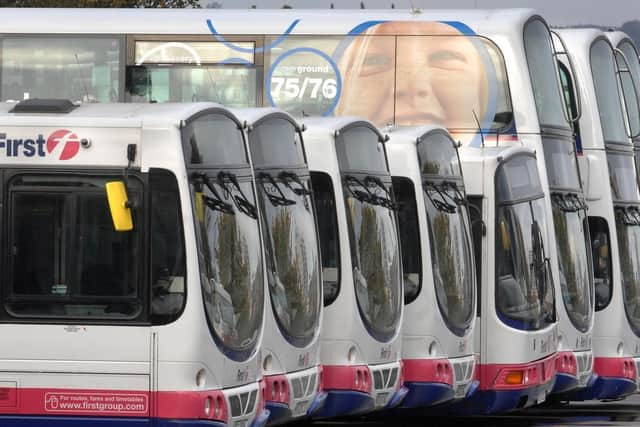The 'left-behind' communities in Yorkshire disconnected from jobs and key services revealed in new report
A new report reveals that so-called ‘left behind’ areas with the poorest connectivity are mostly on the coast or the outskirts of post-industrial towns and cities in the North and Midlands.
Of these 225 areas which have seen their social infrastructure decline disproportionately compared to the rest of the country, 28 are in Yorkshire, according to the All-Party Parliamentary Group for 'left behind' neighbourhoods.


Advertisement
Hide AdAdvertisement
Hide AdAnd two communities, Orchard Park and Greenwood in Hull and Stainforth and Barnby Dun in Doncaster, rank within the top 20 most disconnected areas on the list.
The report ‘Connecting communities: improving transport to get ‘left behind’ neighbourhoods back on track’, produced by Campaign for Better Transport, highlights how people in these areas are reliant on public transport but have worse access to it than other areas.
Some 84 per cent of ‘left behind’ neighbourhoods have worse overall connectivity than the England average and 40 per cent have no car, compared to the England average of 26 per cent.
Local authority-supported bus services in ‘left behind’ areas declined by 35 per cent over the last six years, while commercial services declined by 11 per cent, the report says.
Advertisement
Hide AdAdvertisement
Hide AdEarlier this month, the Government launched its long-awaited National Bus Strategy for England which aims to reform the way local bus services are planned and delivered, requiring local transport authorities to form enhanced partnerships with bus operators, backed by £3 billion investment over the course of this parliament.
Other measures include simpler, price-capped fares, more services in the evenings and at weekends and bus priority measures to improve journey times.
This week Greater Manchester metro mayor Andy Burnham announced that the area's buses would be brought under local authority control for the first time since deregulation in the 1980s.
Such a system, which already operates in London, is being considered by South Yorkshire s metro mayor Dan Jarvis and the West Yorkshire Combined Authority.
Advertisement
Hide AdAdvertisement
Hide AdSilviya Barrett, Head of Policy, Research and Projects at Campaign for Better Transport, said: "As this report shows, it's hard to overstate the importance of good public transport.
"Communities that struggle to access jobs, training and essential services have no chance of thriving. The Government must invest in public transport to ensure that no communities are left behind and that we build back better in a way that is fair and sustainable.
“Reconnecting lost rail links, reinstating cut bus routes and ensuring local authorities have the funds and skills to provide the public transport local communities need is key to reinvigorating the areas featured in this report and, crucially, ensuring these communities don’t get further left behind."
The report used Knottingley in West Yorkshire as a case study, where locals on the Warwick Estate are lobbying for better public transport. Only one bus route serves the community but does not run after 6pm.
Advertisement
Hide AdAdvertisement
Hide AdThe lack of an evening bus service worsens social isolation and contributes to low level crime, says the report. And while there is a train station less than half a kilometre away, there is no easy, direct route to it, because the station entrance is on the ‘other side’ of the tracks.
The report recommends that government prioritises investment in ‘left behind’ neighbourhoods and suggests that funds should be directed to the hyper-local level to support communities and advocate for their needs.
Labour co-chair for the APPG, Hull North MP Dame Diana Johnson, said: “The government must do more to provide equality of opportunity for ‘left behind’ neighbourhoods, so they don’t end up falling even further behind, and providing good quality public transport is an essential part of this.
“Whilst investment in town and city centres can provide opportunities, that’s little help if people living several miles away aren’t able to get to them. To really support residents living in ‘left behind’ neighbourhoods, we need to invest in local people and their capabilities as well as the essential infrastructure like public transport, that they so heavily rely upon.”
Advertisement
Hide AdAdvertisement
Hide AdThese are the 28 neighbourhoods listed as 'left behind' in Yorkshire and the Humber:
- Airedale and Ferry Fryston
- Balby South
- Bentley
- Bransholme East
- Bransholme West
- Dearne North
- Dearne South
- Hemsworth
- Knottingley
- Longhill
- Maltby
- Marfleet
- Mexborough
- Middleton Park
- Monk Bretton
- Orchard Park and Greenwood
- South Elmsall and South Kirkby
- Southcoates East
- Southcoates West
- Southey
- St Andrew's, Hull
- St Helen's, Barnsley
- Stainforth & Barnby Dun
- Tong
- Valley
- Wakefield East
- Wingfield